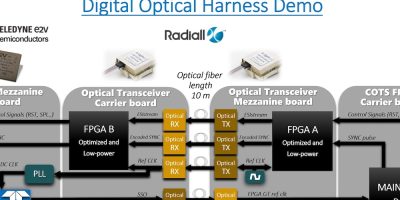Teledyne presses on for software defined microwave systems
Teledyne e2v has developed a prototype optical link technology which it believes might soon make legacy copper data link is digital radio system design obsolete. The optical digital harness (ODH) optical link technology is another step towards enabling software defined microwave systems, said the company.
Streaming sample, control and configuration data, as well as reference clock and synchronisation signals via optical fibres simplifies signal distribution and reduces cable mass in complex digital radio designs, explained Teledyne e2V. Eliminating all copper signal wiring in future radios offers has multiple benefits. In addition to increased architectural flexibility, it reduces crosstalk and inter-channel interference.
According to Nicolas Chantier, strategic marketing director: “Our optical data link research marks a moment in time when the radio’s front end can finally be decoupled from the advanced backend digital data processing of software defined radios (SDRs). In so doing, designers gain implementation flexibility, enhanced digital beam forming capabilities and several extra design freedoms”.
Today’s high speed, copper-based serial data interfaces are either the JESD204 link or the license-free ESIstream from Teledyne e2v.
Data interfacing in sampled systems requires considered implementation, particularly in highly parallelised, multi-channel (i.e. electronically steered beam) systems, where data samples need to be accurately time aligned to ensure signal phase information and thus, the critical spatial information embedded within the received signals, is preserved.
Cross-channel synchronisation is further complicated by meta stability – an inherent, pseudo-random behaviour of digital systems.
The move from traditional copper in radio front end design to optical data link technology provides multiple system benefits including lossless, long range transmission, freedom of separation between front end receive and signal processing systems and weight reduction, In addition, zero EMI lowers crosstalk and signal interferers.
The ODH system is at the proof-of-concept stage. Teledyne e2v has simulated the digital design of the control methods and is currently finalising the first hardware implementation.
The company plans several updates throughout this and next year as the project progresses.




